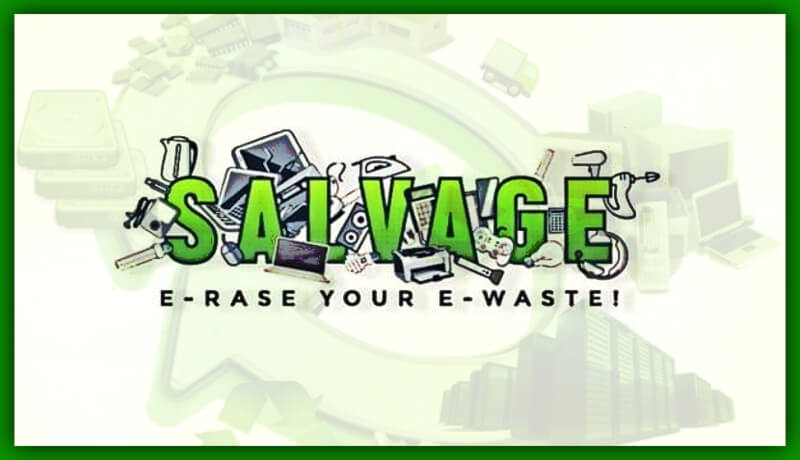SALVAGE – E-rase your E-waste was an online awareness campaign carried out as a part of the green-life initiative under the environmental services avenue of RACUOCFMF. The main objective of this effort was to create awareness regarding the detrimental effects of e-waste with a focus on useful tips to reducing, reusing and recycling electronic equipment. We shared a series of well-designed posts highlighting these aspects in popular social media platforms such as Facebook, Instagram and WhatsApp over a course of three weeks from April 5, 2020 to April 29, 2020.
Today we are witnessing an increase in awareness activities surrounding climate change with the attempt to rescue the only planet known to host life – mother Earth! We are taking initiatives to plant trees, protect wildlife and their habitats while making the slow and inevitable transition into a more eco-friendly and sustainable life style. A crucial part of this effort includes the – not so broadly spoken about topic- “managing e-waste”.
[smartslider3 slider=”177″]
Technology is advancing at a rapid pace like never before, introducing new electronic products with attractive features each day. E-waste is simply the obsolete or unusable electronic products discarded due to a change in trend or due to nearing its end of useful life. This consists mostly of large household appliances-42%, followed by waste from IT and communication technology-34% and consumer electronics-14%. E-waste has become one of the largest global issues due to the increasing problem of improper handling and disposal.
The amount of e-waste generated globally accounted to a massive total of 44.7 million metric tons in the year 2016. Out of this total, a staggering 18.2 million metric tons (40.7% of the total) was generated from Asia which is a 63% increase within the last five years. What is even more shocking is the fact only 15% of this e-waste is recycled in Asia! Ceylon Waste Management estimates that there are 7.6 Mn CRT TVs and monitors in Sri Lanka, of which only 10% is properly disposed. The remaining 90% accounts for 8840 tons of lead and 110 tons of arsenic which is a massive amount of poison leaching into our ecosystem.
The UN warns of the need to improve proper recycling and disposal methods to prevent serious environmental and health consequences in Asia. Most people are unaware of the implications of e-waste on the environment, ecosystem, and the health of humans and wildlife alike. E-waste contains a spectrum of toxic chemicals such as Lead, Copper, Cadmium, Mercury, Arsenic and Dioxins which on exposure triggers serious health complications in humans including birth defects, damage to the brain and other vital organs such as heart, liver, kidney and the skeletal system. Improper disposal of e-waste allows these harmful chemicals to leach out, contaminating the soil, ground water and air which in turn lead to the accumulation of these heavy metals in the cells of crops, livestock and wildlife, passing up along the food chain.
This process is known as Bioaccumulation and that is how we can be consuming poison on a daily basis. As John Gertsakis said “The cost of inaction will far exceed the cost of dealing with the problem over short term”. The magnitude of this issue forces us to act before it is too late.
[smartslider3 slider=”178″]
The Waste Electric and Electronic Equipment Forum (WEEE Forum) is the world’s largest multinational center concerning e-waste which has initiated many programs in raising awareness on e-waste. It has encouraged e-waste recycling to a great extent with the support of 40 e-waste producer responsibility organizations across the world. These member organizations of the forum are involved in collecting, de polluting and recycling e waste. The Forum introduced the international E-waste day in 2018 with the aim of further emphasizing the need of proper E-waste disposal and recycle.
[smartslider3 slider=”179″]
SALVAGE was our attempt at making a contribution to this larger effort. We encouraged the audience to re-evaluate, reducing consumption, repairing worn equipment, donating used products and storing them until being recycled. We also highlighted ways to minimize the impact of e-waste by extending the life of electronics with better care, buying EPEAT and energy star electronics, posting unused large electronics to Harvard’s Reuse site and recycling electronics and batteries in e-waste bins. With the pleasure of having successfully conveyed this message, we aim at extended commitment to this cause and the environment by initiating collection of e-waste from next year. Let us SALVAGE this planet by E-rasing our E-waste!
Written By:

Rtr. Hamdha Shifar
( Member – 2019/20 )


